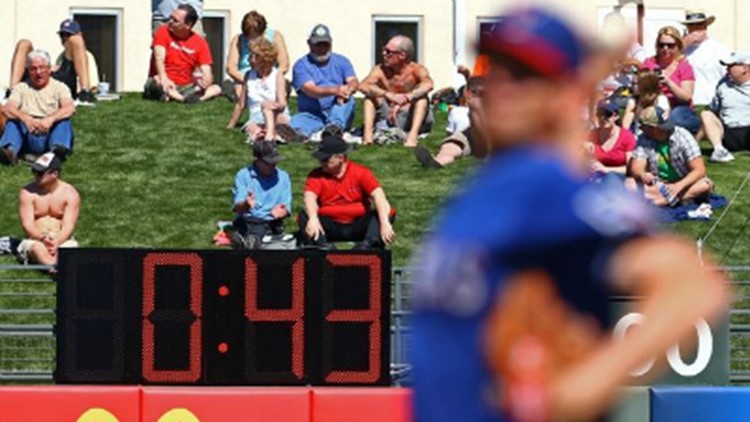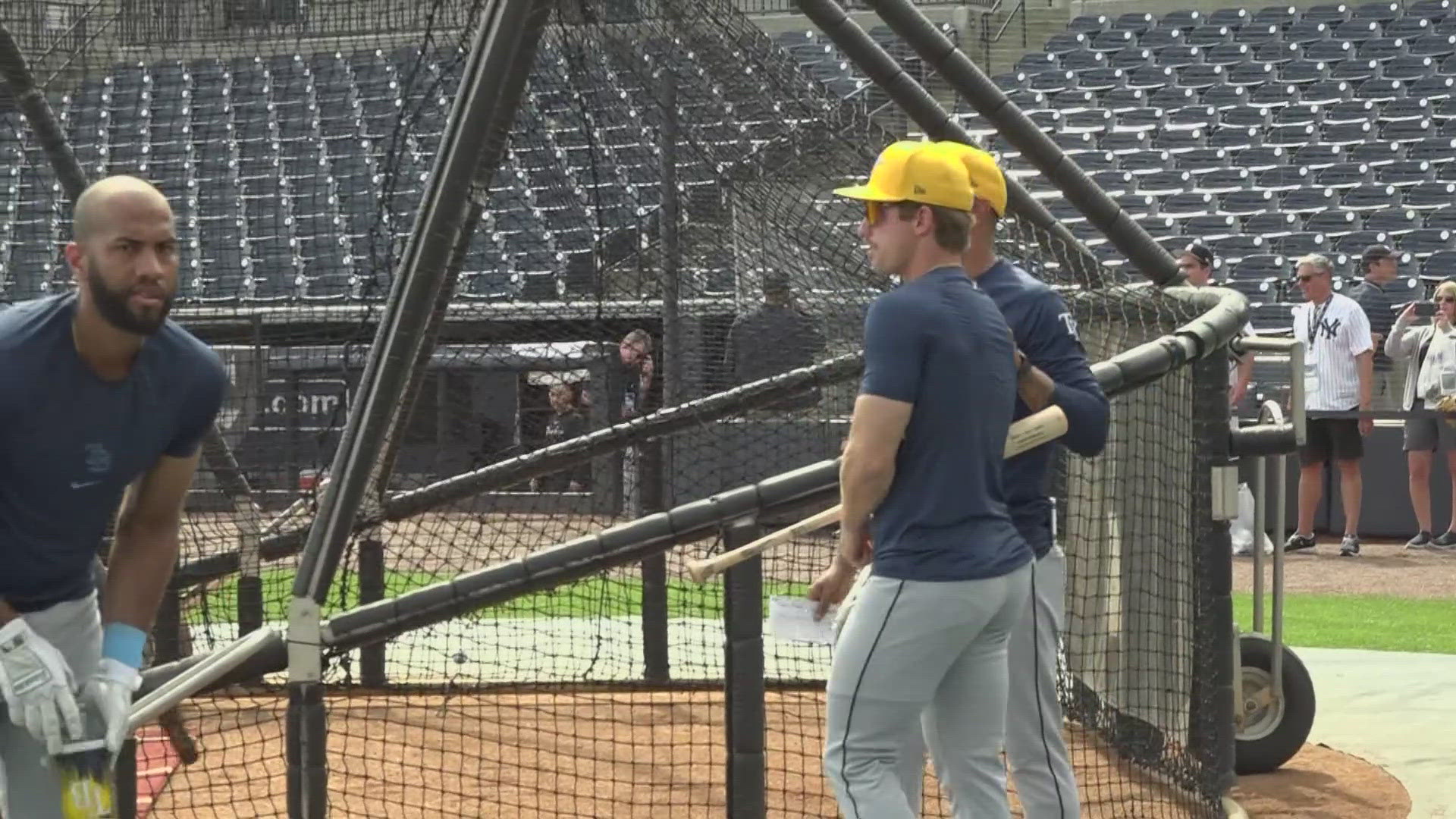ST. PETERSBURG, Fla. — Major League Baseball is unilaterally starting to use pitch clocks for spring training games this year.
Pitchers will have 20 seconds to deliver to the plate when exhibition games start in Arizona and Florida.
The Cactus League play starts Thursday and Grapefruit League games start Friday.
The intention is to get players and umpires accustomed to the clock in the event MLB makes the rule change for the upcoming regular season.
"We will start getting ready for the possibility that we're going to use the pitch clock on opening day," Commissioner Rob Manfred told the Associated Press on Sunday at spring training media day in Florida. "We have to get going."
After the 2016 and 2017 seasons, players rebuffed management's proposal for a pitch clock. Now, owners and Manfred have the right to implement one this year without consent from the players’ association under the provisions of the collective bargaining agreement.
However, Manfred has been reluctant to initiate on-field modifications without agreement from players and their union head, Tony Clark.
"We're still hopeful that we're going to make an agreement with Tony on pace-of-play initiatives," Manfred said. "I just think that whether it's by agreement or otherwise, the only prudent course for us at this point is to be in a position to proceed if in fact we have an agreement or decide to do it ... under our collectively bargained right to do that."
The players’ association released the following statement:
"This is not the result of an agreement with the players' association. Discussions regarding several on- and off-field issues remain ongoing."
How would umpires enforce the pitch clock?
Here is how a pitch clock is enforced at some levels of the minor leagues: If a pitch isn't thrown within 20 seconds, a ball would be called. If the hitter isn't in the batter's box with five seconds remaining, a strike would be called.
Manfred said the rules involving the clock will be "phased in" and won't start immediately with ball and strike calls. But there will be a "functional" clock in Grapefruit League and Cactus League games. Management's proposals have said a clock would not be used after foul balls.
Here’s a video example of an umpire enforcing the pitch clock rule during a 2014 Arizona Fall League game. There is no word on specifically how MLB would enforce a pitch clock with runners on base as shown in the video.
Here’s how the 20-second rule is explained at the minor league level with runners on base:
- The timer will stop as soon as the pitcher begins his wind-up or begins the motion to come to the set position.
- If the pitcher fakes a pickoff or steps off the rubber with runners on base, the timer shall reset and start again immediately.
Which MLB pitchers take the longest and which work the fastest?
A stat called Pace is used to measure the average time between the pitches in a plate appearance. Go to FanGraphs’ website to read about the specifics of how it is measured.
The categorization below shows a pitcher’s Pace.
Fast: 20 seconds
Above Average: 20.5 seconds
Average: 21.5 seconds
Below Average: 22.5 seconds
Slow: 23.5 seconds
Here are the pitchers with the five slowest Paces in MLB so far during the 2018 season, according to FanGraphs:
Editor’s Note: Pitcher in bold: Average Pace (seconds)
- David Price, Boston Red Sox: 26.7 seconds
- Justin Verlander, Houston Astros: 26.3 seconds
- Zack Godley, Arizona Diamondbacks: 25.5 seconds
- Aaron Nola, Philadelphia Phillies: 25.4 seconds
- Jake Odorizzi, Minnesota Twins: 25.4 seconds
Here are the pitchers with the five fastest Paces in MLB so far during the 2018 season, according to FanGraphs:
- Mike Foltynewicz, Atlanta Braves: 20.1 seconds
- German Marquez, Colorado Rockies: 20.3 seconds
- Jose Urena, Miami Marlins: 20.4 seconds
- Zack Wheeler, New York Mets: 20.6 seconds
- Sean Newcomb, Atlanta Braves: 20.7 seconds
Why is MLB deciding to implement a pitch clock now?
The average MLB game has taken at least three hours for the past seven seasons. Data from Baseball Reference shows the 2000 season was the only other year the average game was three hours or more.
The 2014 MLB season marked the first season the league expanded its video review process. Managers are allowed one challenge over the first six innings and two from the seventh inning until the end of the game.
The league decided to limit the replay reviews to two minutes at the start of the 2017 season.
10News first reported in July 2017 how the league considered implementing pitch clocks for the 2018 season. It never happened despite Minor League Baseball implementing them at the Double-A and Triple-A levels before the start of the 2015 season.
The Associated Press reported the Double-A and Triple-A leagues with 20-second clocks cut their average games down by 12 minutes from 2014 to 2015. Is that saved time really going to appeal to an audience that can get a video recap on Twitter or YouTube almost immediately after a game?
Remaining questions about the spring training pitch clock
If MLB decides to implement the pitch clock for the 2019 season, it raises several questions:
- Can you imagine an umpire issuing a ball or strike based on the clock during a tense playoff series when games often take longer than the regular season? What if it determined the outcome of a key playoff game, especially after the fiasco NFL referees faced in the NFC championship game?
- Would fans want umpires to abide by the proposed pitch clock rules, or would umpires enforce playoff games differently than the regular season?
- Why are pace-of-play initiatives a priority for Manfred?
- Should Manfred consider how MLB can partner with casinos and sportsbooks now that individual states can decide whether to legalize sports gambling?
Mark Bergin is a journalist with 10News WTSP. Like him on Facebook and follow him on Twitter and Instagram. You can also email him at mbergin@wtsp.com.
►Make it easy to keep up-to-date with more stories like this. Download the 10News app now.
Have a news tip? Email desk@wtsp.com, or visit our Facebook page or Twitter feed.



